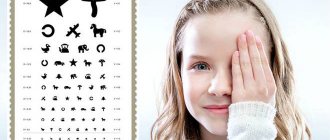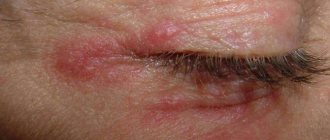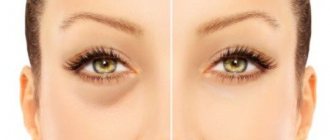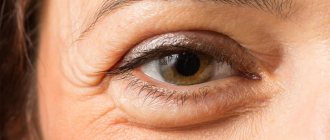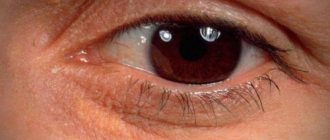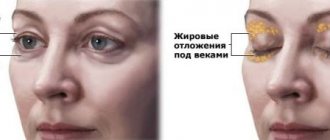The main reasons for the appearance
Milia most often appear near the eyes.
Small formations on the skin of a white-yellow color, filled inside with subcutaneous fat and keratin, which do not cause painful or unpleasant sensations, are called milia or millea.
Most often they appear on the face in the area of the nasolabial triangle, near the eyes, and on the chin.
Medicine cannot give an exact answer to the question of why millet grasses form. They make the following assumptions:
- imbalance of major hormones in the body;
- disorders of the thyroid and pancreas;
- gastrointestinal diseases;
- improper diet;
- poor skin care;
- increased sebum production;
- exposure to UV rays.
As a rule, milia open on their own after 5 to 7 days. If they constantly appear and do not disappear for a long period of time, this is a reason to conduct a comprehensive examination of the entire body!
Causes of white pimples on the eyelid
There are 2 possible options for the appearance of formation on the eyelids:
- primary appearance - associated with the accumulation of fatty deposits under the skin for unclear reasons;
- secondary appearance - the cause is associated with pathologies, for example, nutritional factors, metabolic disorders, damage to the surface layers of the skin.
Such formations are located under the skin and are not connected to the pores. Therefore, environmental access to the subcutaneous layer is completely blocked. In this regard, inflammation does not form; purulent lesions are possible only when the skin is damaged.
The following external and internal factors can affect the skin, leading to the formation of milia:
- daily exposure to ultraviolet radiation on the skin;
- hormonal disorders or temporary changes associated with a certain age, for example, acne in adolescents, skin formations in women during menopause;
- poor nutrition with a large amount of incoming carbohydrates and fats, which do not have time to be excreted from the body, but are deposited inside the tissues;
- hereditary factor;
- reduced amount of nutrients supplied to the body, especially vitamins, microelements, minerals;
- frequent drinking of alcoholic beverages, smoking;
- applying low-quality cosmetics to the skin of the eyelids, which patients often forget to wash off before bed;
- disease of the liver tissue, this condition is especially common in fatty degeneration;
- disruption of the functionality of the gastrointestinal tract, which is accompanied by a reduced supply of nutrients through the intestines into the blood.
Treatment for the condition depends on the cause that caused it. If you simply mechanically remove the contents of the acne, the condition will reoccur. Patients need to change their diet and consult an endocrinologist.
Clinical manifestations
Milia in children and adults is only a cosmetic defect that does not affect the quality of life. However, it is worth highlighting some features of whiteheads that make it possible to distinguish them from similar skin rashes:
- are formed gradually and absolutely painlessly;
- not prone to merging into one large spot;
- more often they are formed in groups, although the presence of 1-2 separate points is not excluded;
- cysts are light in color, sometimes with a yellow tint;
- never grow larger than 3 mm;
- They never become inflamed on their own, because accumulated sebum does not have direct access to the surface of the skin. The only exception to this rule is when pathogenic bacteria enter the eel for some reason. In this case, inflammation develops, and the milium itself transforms into an abscess;
- do not grow for a long time;
- often appear only on the face.
The most common places to see whiteheads are:
- on the nose (in 90% of cases it is diagnosed in infants);
- on the eyelid (here white dots rarely occur in single copies);
- on the cheeks and forehead;
- in the paraorbital zone;
- in the area of the cheekbones and temples.
In addition to the usual places where milia are localized, there are areas where small white dots are formed extremely rarely:
- under the eyes;
- on the lips;
- on the limbs;
- on the genitals;
- in other parts of the body.
All patients who are faced with a similar cosmetic defect should remember that they cannot squeeze out the acne themselves. Aggressive actions will lead to injury not only to the skin, but also to the sebaceous gland itself. As a result, amateur activity will lead to the formation of a huge blackhead, inflammation and the formation of a rough scar.
Causes of milia in the eye area
Medicine does not yet know the exact answer why white spots appear under the eyes. Predisposing factors to the formation of the defect are considered to be:
- hormonal imbalance - they often occur in adolescents entering puberty and in women during menopause;
- disruption of the digestive system caused by diseases or poor diet;
- abuse of sun exposure;
- minor disorders in the functioning of the endocrine system;
- neglect of hygiene measures;
- use of inappropriate or low-quality cosmetics.
You can get rid of millet by solving health problems and using cosmetic measures.
Milia on the eyelids of a newborn do not require treatment. This physiological phenomenon is caused by the passage of the baby through the birth canal, and after a few days they disappear on their own.
Salon removal techniques
Only a cosmetologist or dermatologist can recommend the best way to remove grasses depending on their location, their total number, proximity of blood vessels, skin type, and so on.
Modern cosmetology offers the following types of techniques for eliminating milia:
- a mechanical method of removal, most often carried out in beauty salons. For this purpose, thin surgical needles that have undergone antiseptic treatment are used, with the help of which the millet is pierced, their contents come out, and the skin in this place is thoroughly disinfected. In one session, it is allowed to remove about 10 milia to prevent injury to the skin surface;
- electrocoagulation, used in cases where the patient is afraid of puncturing the skin with a needle. This method is no less popular than the previous one. Its essence is the direct effect on the affected skin of low-power and high-frequency alternating current electrical impulses. The current, penetrating under the skin, destroys the accumulation of subcutaneous fat, which instantly comes to the surface. Immediately after the session, a crust appears in the treatment areas, which disappears on its own over the next few days. This method of removal involves special home care for the epidermis, which consists of regularly treating damaged skin with antiseptic solutions;
- laser coagulation, which is an absolutely painless and safe method of eliminating this skin defect. The laser beam affects only the grass, without affecting healthy areas of the epidermis at all. Simultaneously with the removal of milia, the process of disinfection of the damaged skin area occurs. The method completely eliminates the appearance of bleeding, however, after the session, crusts will appear in the treatment areas, completely disappearing within 2 weeks;
- curettage, especially popular due to its affordability compared to other techniques. A special feature of the method is the removal of millet with the help of special medical instruments (a curette or a Uno spoon, which in appearance resembles a small spoon with a hole located in the center). The effectiveness of this method lies in the removal of not only the milia, but also its capsule, which serves as a place for the re-formation of the defect. The disadvantage of this method is the possibility of strong pressure and subsequent injury to the epidermis, which can result in scarring.
Due to the presence of contraindications to each of the techniques, consultation with a dermatologist or experienced cosmetologist is mandatory.
Methods for removing milia on the face
The best way to remove whiteheads is, of course, in your doctor's office. Only a professional can do this as carefully as possible, without injuring nearby healthy tissue. There are several techniques to get rid of unsightly acne:
- Curettage, or mechanical action. Usually, curettage is resorted to when the rashes are not multiple. This technique is quite simple - the cyst is carefully punctured and then squeezed out along with the capsule. Less commonly, the formation is scraped out using a special curette.
- Laser coagulation. The modern method gets rid of unsightly whiteheads quickly and easily, even in their atypical and difficult-to-reach location. During the procedure, the doctor acts on the desired area with a carbon dioxide laser, which can remove pathological tissue layer by layer without affecting healthy tissue. Also, the beam directed to the lesion has a pronounced bactericidal effect, which eliminates inflammatory reactions or bleeding.
- Electrocoagulation. The procedure involves burning white dots using electricity. One of the main advantages of electroagulation over other treatment methods is its excellent effect with very little trauma to nearby areas. However, this technique has its drawbacks: since the procedure is quite painful, the skin must first be anesthetized, and after electrocoagulation there is a small chance of scar formation. It makes sense to treat whiteheads with electrocoagulation if the milia are too deep and cannot be removed with curettage or laser.
If whiteheads appear in a newborn child (very often on the upper eyelids), no procedures are required to remove them; they will go away on their own after some time. You just need to properly care for your baby’s skin using hygiene products prescribed by your pediatrician.
Milia under the eyes: treatment
It is quite difficult to eliminate such formations using folk remedies. This is talked about not only by doctors, but also by the supporters of alternative medicine themselves. Therefore, if such a cosmetic defect appears, doctors recommend not to engage in useless self-medication, but to immediately contact a cosmetologist at a beauty salon.
Can milia under the eyes disappear on their own? How to get rid of this disease at home? Experts say that in adults such formations usually do not go away on their own. As for small children, the white spots gradually disappear during development. Therefore, it is not possible to treat milia at home. This requires specialized equipment.
Recommended ointments
To get rid of milia at home, the following formulations are recommended:
- sulfur, salicylic or zinc ointments, which have drying, regenerating, brightening and antibacterial properties. They are applied in a thin layer to cleansed skin in areas of existing rashes every day at night for 10 days;
- pharmaceutical ointment "Retinol" applied in a thin layer locally (on the grass) after washing the skin. It is strictly forbidden to apply this ointment to the area near the eyes to avoid burns and irritation of this delicate and especially sensitive epidermis!
- ichthyol ointment, which has an unpleasant odor, but is very effective in the fight against milia, characterized by anti-inflammatory, antimicrobial, powerful regenerating and improving local blood circulation effects. Cosmetologists strongly recommend using this ointment after performing mechanical or hardware cleansing of the skin, including for preventive purposes. It is recommended to apply it to rashes only in the evening, before bed.
Pharmacy ointment "Retinol" will help in the fight against milia.
Video: Causes of appearance on the face
In the video - removal of milia on the face:
The procedure for removing whiteheads at home is carried out as follows: the skin formation must be pierced with a needle and the contents squeezed out. But it is not always possible to carry out manipulation at home, since sometimes milia are located deep in the subcutaneous layers.
Traditional medicine is also rich in recipes that used to help people treat and get rid of this problem:
- Viburnum juice. To prepare the composition, you need to take the berries and crush them using a wooden pestle. Pour the resulting juice into another container. You can use the juice as a preventive measure or apply gauze soaked in it to eliminate existing skin formations. You can also prepare an effective mask by mixing juice and oatmeal. As a result, you should get a creamy mass. It is applied to the affected area and kept there for 45 minutes.
- Cucumber juice. To combat millet weeds, you can use fresh cucumber. Remove the peel and seeds from it. After this, take the pulp and finely chop or grate. Pour water over the pulp, wait 4 hours, and then apply to the affected area and hold for 30 minutes.
Causes
The appearance of milia does not depend on gender or age. Milia often appear in adolescents; they are also common among adults.
It is a misconception that the appearance of milia is a consequence of a blocked skin pore or an enlarged sebaceous gland. According to physiological characteristics, the location of the neoplasm is the space of the epidermis separate from the hair follicles, sebaceous and sweat glands.
Milia are cysts, the structure of which contains cystic walls, a capsule and an admixture of subcutaneous fat. The inside of the cystic capsule is keratin accumulations (keratinized epithelial cells), mixed with a small amount of subcutaneous fat.
It has been established that the formation of retention cysts is a consequence of hyperkeratosis. With it, increased cell division occurs in the upper layer of the epidermis and, at the same time, a slowdown in the processes of exfoliation of keratinized skin particles.
The exact causes of milia formation are not known. The following factors influence:
- genetic predisposition;
- hormonal imbalances (in adolescence, during menopause, during pregnancy);
- pathological disorders of the thyroid gland and endocrine diseases;
- diseases associated with impaired functionality of the pancreas;
- pathologies of the gonads;
- poor nutrition (poor diet, deficiency of vitamins and mineral components, excessive consumption of fatty and fried foods);
- diseases of the digestive tract;
- use of incorrect cosmetics;
- Excessive exposure of the skin to sunlight.
What are milia on the eyes
Medical practice shows that milia are diagnosed in adolescents and adults, but can occur during the neonatal period. The rash does not appear quickly and does not cause discomfort to the patient.
Milia are subcutaneous nodular formations that protrude slightly above the skin. They can be localized either as individual elements or in groups.
In the thickness of the skin there are sebaceous glands that secrete a fatty secretion such as sebum. Sebum is formed during the cellular breakdown of the sebaceous gland and is a rather complex mixture. When fatty secretions enter through the hair follicle onto the surface of the epidermis, a special emulsion film is created. It is necessary to maintain the normal condition of the epidermis and hair. It is through the mouth of the hair follicle that the desquamated epithelial cells are removed.
Even with strong impact, it is not possible to squeeze out the contents of milia. In some situations, when puncturing a cystic formation, white contents may be released.
Folk remedies
Traditional medicine offers the following methods to eliminate blemishes on the face:
- juice from viburnum fruits, crushed in a mortar or blender, strained through cheesecloth. Using a cotton pad, wipe the affected areas of the epidermis with this juice after preliminary cleansing;
- herbs chamomile, celandine, calendula, St. John's wort, string, yarrow, eucalyptus help deeply cleanse pores, kill pathogenic microflora, regulate sebum secretion, soothe and protect against infections. Pour a glass of boiling water in the amount of a tablespoon, cover with a lid, leave for half an hour, then filter and use a cotton pad to wipe the problem areas of the skin.
What it is
Milia are cystic formations in which the wall is lined with epithelial cells. The contents of the neoplasm consist of an accumulation of keratin, which is formed from keratinized cells of the dermis. And only occasionally there is a small amount of sebum present.
The same applies to papillomas on the eyelids. Having a viral nature of origin, the essence of the formations is the growth of the epithelial layer of the skin and the formation of growths. Along with milia, these abnormal formations can cause discomfort and spoil the appearance. Read more about papillomas on the eyelids in the article.
Milia are autoimmune in nature, i.e. their appearance indicates a malfunction of internal systems. Therefore, before removal, it is necessary to conduct a diagnosis to determine the cause of this rash.
Recipes for effective masks and scrubs
Such compositions help to quickly get rid of whiteheads, and are also recommended by cosmetologists for speedy healing and restoration of the skin after salon mechanical cleaning of the epidermis:
- from raw cucumber, peeled, seeds and grated on a fine grater to a pulp, poured with boiling water, covered with a lid, wrapped in a towel and infused for 2 hours. To carry out the procedure, you need to take natural fabric (linen or cotton), cut it to the shape of your face, and make holes for the eyes, nose and mouth. After the infusion has cooled, a fabric mask is dipped into it, squeezed lightly and applied to the face. Periodically (every 5 minutes the fabric is moistened again in the solution). The procedure takes about 20 minutes. If the skin is dry or withering, instead of water, the cucumber can be poured with hot milk, and after the composition has infused, add a little sour cream;
- based on natural honey and yeast, it has drying properties and normalizes sebum production, therefore it is very useful for skin affected by millet. This is how it is done. Soft baker's yeast in the amount of 25 grams is combined with liquid honey, lemon juice and 3% hydrogen peroxide (1 tablespoon each). The composition is mixed well and applied to cleansed skin in a thick layer, left for at least 20 minutes. The frequency of using this mask is 2 times a week;
- with freshly squeezed viburnum juice and oatmeal, mixed to form a thick mushy mass, helps not only cleanse the skin, but also increase its elasticity. This mask should be kept on the skin for at least half an hour;
- pumpkin mask has a cleansing, regenerating, moisturizing and toning effect. Raw, peeled pumpkin is crushed using a fine grater, adding a little sour cream and thoroughly mixing the mixture. Apply this mask to a cleansed face steamed over a decoction of herbs, leaving it on for about 20 minutes. This mask normalizes all metabolic processes occurring in the skin;
- a scrub of salt and soda, taken in equal proportions, is applied to a soapy face and they begin to rub the composition in a circular motion into problem areas of the epidermis. It is recommended to do this procedure carefully and carefully, avoiding redness of the skin surface. Immediately after the procedure, you need to wash off the composition from your face with warm boiled water and apply a mask of sour cream and salt (1:1) for about a quarter of an hour. After this, you need to wash your face again with warm, soft water. For skin prone to dryness, it is better to make a scrub of olive oil and soda.
We wish you to rid your skin of milia as quickly as possible!
Removing millet at home using traditional methods
Milia that appear on the face are a nuisance, to combat which you can use available folk methods. Successful removal of pathology requires long-term treatment.
It is better to use folk remedies weekly even with healthy skin - this prevents the appearance of inflammation and pimples.
The means used are:
- slow down the growth of old cells;
- exfoliate;
- stimulate the regeneration process.
Various types of peelings are better suited for this role: using soda, salt, plant fruits, yeast and other products.
How to remove white pimples under eyes with baking soda
Baking soda is an effective way to combat white millet. The most popular is soda peeling to remove rashes:
- soap suds are mixed with baking soda;
- the place where milia have formed is treated with the solution using massage movements;
- peeling is washed off with clean water;
- A compress is made from an infusion of herbs: chamomile and calendula to relieve irritation.
This method is only suitable for oily skin types. If you have a dry type, it should not be used due to active drying of the skin.
How to remove small white millenniums or pimples with paraffin?
Warm paraffin masks allow you to achieve rapid skin regeneration by removing the old layer of epithelium and activating cell nutrition.
For deep cleansing using paraffin peeling, only areas of skin without hair are suitable - since paraffin negatively affects the condition of the hair follicles. The paraffin mask is made as follows:
- melt paraffin in hot water;
- the face is wiped with an alcohol-containing lotion or alcohol solution;
- paraffin is applied using a brush;
- after hardening, another layer is applied;
- another one is applied to the frozen one, and we repeat the procedure until the thickness of the mask reaches 1-2cm;
- After removing the mask, you need to wipe the surface of your face with a herbal decoction or apply a herbal compress.
Before applying paraffin, you should not wipe your face with a water lotion or infusion, as there is a danger of getting a thermal burn.
Salt
To make a mask from salt, it is best to use marine analogues, but table salt will also work.
Ingredients for peeling: sour cream and salt. Apply the product in the same way as a mask of soda and soap solution.
How to treat a watery pimple near the eyes with pumpkin?
The mask is made like this: the fruit is grated and mixed with sour cream. Then the product is allowed to brew for about three hours. Apply to the face for 15-20 minutes, after which the mask is washed off. If you use cucumbers, oatmeal, garlic or potatoes, you need to add olive oil. Ordinary honey can be used as a mask.
Viburnum - how to get rid of a white dot inside the eyelid?
A mixture of sugar-free viburnum juice and oatmeal is applied to the face and left on for 20-30 minutes.
Yeast
Compound:
- 25g yeast
- 1 tbsp. spoon 3% hydrogen peroxide
- 1 tbsp. spoon of natural honey
- 1 teaspoon lemon juice
The components are mixed and used as a mask for 15-30 minutes.
Treatment of milia
How to get rid of milia under the eyes? In many cases, they go away on their own, without affecting them and leaving no trace. Today, the only way to get rid of millet grains is to go to a cosmetology clinic, where, after consulting a cosmetologist, the patient is prescribed individual treatment.
Therapeutic treatment involves the use of several methods: laser removal of milia, mechanical removal (curettage), the use of external medications, folk therapy, etc. These methods are described in more detail below.
Laser removal
The most effective and fastest way to remove milia is with a laser, which is carried out using radiation coagulation of the skin. For this procedure, liquefied gas nitrogen, helium, hydrogen, and xenon are used.
Laser removal of milia provides the most favorable effect from a cosmetic point of view, and also has an antibacterial effect on the resulting wounds, which prevents infection.
The advantage of this method is the absence of bleeding, because coagulation (sealing, coagulation) of the vessels occurs.
Mechanical removal (curettage)
How to remove milia using mechanical action, without resorting to laser and tablets? There is a method in cosmetology called “curettage”. The procedure looks like this: a cosmetologist uses a special tool to open the vial and squeeze out the entire contents of the capsule using a curette (hence the name of the method).
A curette is a metal wire with a loop at the end into which a small knot is placed to remove cyst masses.
Cosmetologists note that curettage is relevant for single milia; the method is not suitable for mass rashes. The disadvantage of the method is that after it is carried out, there is a possibility of a relapse, that is, the hollow vesicle can again fill with sebum. In addition, the open wound must be treated frequently to prevent infection.
How to get rid of milia at home?
How to treat the skin problem in question at home? Often, patients begin to get rid of milia on their own, trying to squeeze them out, which is absolutely forbidden to do. This procedure can lead to very negative consequences.
In a cosmetology clinic, the procedure is performed using equipment where infection is excluded. At home, the removal process is carried out with your fingers, which does not exclude infection of the wound and does not guarantee the extraction of the entire contents of the pore.
Treatment with ichthyol ointment
Ichthyol ointment is a medicine for external use that has antimicrobial and anti-inflammatory effects. The ointment can increase the regenerative functions of the skin, and when squeezing out the millet, it helps to have a healing effect, preventing infection.
Specific help is provided by ointment in the treatment of multiple milia, because it not only improves the functioning of the sebaceous glands, but also eliminates rashes. For the procedure, it is enough to apply the ointment in a thick layer, cover it with a sterile napkin and wait until there is a feeling of warmth.
Removal using masks
It is impossible to treat pimples under the eyes with cosmetics, but regular use of face masks will have a general tonic effect on the skin and prevent the subsequent appearance of milia.
Let's look at the most popular recipes for making masks at home.
- Viburnum berry mask . To prepare the mixture for the mask, you will need 2 tablespoons of berries, which must be crushed until abundant juice appears, and then add 1 teaspoon of oatmeal to the juice. Mix well and apply to the area under the eyes, nose, cheeks, forehead. Leave for 20-25 minutes and rinse.
- Cucumber and ground coffee . To prepare the slurry for the scrub mask, take a peeled cucumber, grate it, add 1 teaspoon of ground coffee. Mix well, apply to face with light massaging movements so as not to injure delicate skin, leave for 5 minutes and rinse with water. Coffee particles help remove dead epithelium and soften the surface of milia, which makes it easier to open and extract their contents.
- Yeast mask . This product significantly reduces the level of secretions from the sebaceous glands and dissolves excess fat accumulation in the pores. To prepare, take 1 dessert spoon of fresh yeast, 1 tbsp. spoon of lemon juice, 1 tbsp. spoon of hydrogen peroxide (3%), 1 tbsp. a spoonful of natural liquid honey. It’s good to melt everything in a water bath, without bringing it to a hot state. Make an application on your face, and after 15 minutes, wash off the dried mass. After rinsing, apply a light cream to your face.
- Soda peeling . The product is suitable for people with oily skin types. Grate a little baby soap, lather it and add 1 tbsp. spoon of regular baking soda, stir until smooth. Without strong pressure, rub the skin under the eyes, cheeks, forehead, nose and chin with foam in a circular motion using a cotton pad. 7 minutes after application, rinse everything thoroughly. The skin may turn red after such a procedure, but after 5-6 hours it will look normal.
- Pumpkin mask . Grate fresh pumpkin and add a little sour cream to the resulting mass. The mass should be thick. The mask is applied to the face and left for about 15 minutes, and then washed off.
- Chamomile and calendula mask . This wonderful disinfectant is suitable for everyday use. To prepare it, take 1 tbsp. spoon dried flowers in equal proportions and pour one glass of boiling water. After 40 minutes the infusion is ready. To apply to the face, use gauze soaked in the resulting solution. Keep for about 20 minutes.
Treatment
The patient can choose the treatment method. He can do it at home, but then the possibility of completely eliminating the condition is reduced. Temporary relief of symptoms is possible, but milia formation may then accelerate.
It is recommended to contact an experienced cosmetologist who will select the correct method of treatment that does not cause side effects, depending on the patient’s health condition.
Getting rid of millet at home
There are many traditional methods of treatment. They can be used in patients who do not have an allergic reaction. If there is a history of it, cross-reactions with other substances may occur:
- Lemon juice. You can squeeze out the liquid or use half the fruit. The juice is wiped over the entire area of the eyelid where the milia are located. After 10 minutes, wash off, as further presence of juice on the skin can cause allergic reactions, irritation and inflammation.
- Kalina. The juice is squeezed out of the berry, then using a brush or cotton wool, the entire surface of the skin covered with the formations is smeared. After 20 minutes, wash off.
- Sea salt scrubs. Take 2 tablespoons of salt, add olive oil. The resulting mixture is rubbed into the milia area. After 5 minutes they wash.
- Hercules. It is possible to use viburnum juice, to which cereal is added. Knead the resulting mixture with a fork until it becomes a paste. The mixture should be thick and not run off your face. The product is applied to the skin for 40 minutes, after which it is washed off with running warm water.
- Onion. Take a medium-sized onion and bake it whole in the oven. After this, cut the onion in half and let it cool. The juice obtained in the middle of the onion is applied to the surface of the skin. You can take half an onion and wipe your face with it.
- Clay. For these purposes, cosmetic red clay can be used, which is diluted with kefir. A paste-like consistency should form. Apply it to the face, wait until it dries completely, and then wash off with water.
It is important for patients to know that traditional treatments may not help. In this case, the patient's condition will worsen. This result can occur with systemic diseases. For example, if a patient has fatty liver disease, this particular pathology needs to be treated; superficial application of the product to the face will not help.
Medicines
You can buy solutions, gels, and creams at the pharmacy that do not need to be prepared; they are immediately applied to the face:
- Antiseptics. These substances include salicylic acid and furatsilin solution. They help disinfect the skin and eavesdrop on them. Therefore, the formations may gradually decrease. But acne does not completely disappear.
- Vitamin complexes. Necessary for patients who do not receive enough vitamins through food. The condition of the skin is improved by retinol, or vitamin A. It increases the regenerative abilities of the epidermis, helps eliminate pimples and blackheads.
- Vishnevsky ointment. It is suitable for formations that are contained under the skin. After application, the surface part of the eel dries, the ointment helps the contents come out.
- Ichthyol ointment. Relieves inflammation and promotes tissue healing. It must be used daily to achieve maximum effect. This ointment is often used during severe acne lesions.
To prevent adverse reactions from purchased medications, you should first read the instructions. Possible side effects and contraindications are described there.
Mechanical methods
The doctor first disinfects the skin using antiseptic solutions. After this, the contents of the milia are removed using a thin needle. At the end of the procedure, the skin is treated with an alcohol solution to prevent infection.
This method is suitable for those people who have only a few formations on the skin of the eyelids. If there are many of them, the procedure will be excessively painful.
After the procedure, the skin is treated with antiseptic agents to prevent bacterial infection. It is recommended to use creams; antiseptics greatly irritate the skin.
Electrocoagulation
The patient's skin surfaces on which the acne is located are first disinfected. This prevents bacterial infection from getting under the skin. The electrocoagulometer acts on the skin using small electrical discharges. They contribute to the destruction of the contents of the milia. After the technique, a small film or crust forms on the skin, which disappears within 2-3 days.
The technique is painless, the patient feels a slight tingling sensation. But the surface structures of the skin are damaged, so you should use antiseptics to prevent infection.
Laser removal
The most correct method with which you can remove acne containing fatty deposits. The method has virtually no contraindications. The doctor applies an antiseptic and then uses a laser to target the affected areas.
After the technique, a film also appears on the skin, which quickly disappears within a few days. It is recommended to use moisturizing creams, as after the procedure the skin becomes dry.

